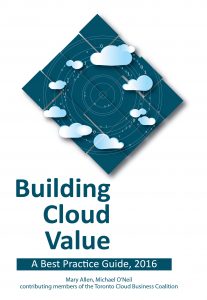
It seems fitting that a guidebook about today’s most pervasive and powerful business technology should have been put together in an innovative manner. The technology is ‘cloud computing’ and the technique for authoring it is ‘crowdsourcing’. The target audience is anyone currently involved, or about to be involved, in the buying or selling of cloud services in Canada.
The broad concept of ‘cloud computing’ is so well known, especially by someone who would pick up this book, that it is not defined in it. But the need, and the ways, to maximize the value of cloud computing are its core purpose – and in this the book succeeds admirably.
The concept of ‘crowdsourcing is not so well known, and may benefit from a brief explanation. The word was first coined just over a decade ago as a mash-up of crowd and outsourcing, and has come to mean any focused joint effort among a set of people who are Internet/social media connected. Its use in fundraising, or crowdfunding, is best exemplified by Kickstarter. Its use in assembling and publishing best practices knowledge is not yet widely accepted. The ‘crowd’ responsible for putting this book together are all members of the Toronto Cloud Business Coalition, which, despite its name, is a Canada-wide organization of both individual and corporate members united in the aim of advancing the adoption and use of cloud computing.
Members of TCBC who showed interest in this endeavour congregated into ten working groups of five to ten members (perhaps driven by the two pizza rule?). Each group focused on a cloud-related subject to which the members brought expertise, and on which each member committed to significant work in creating the content of that chapter. A wise and logical structure of the ten chapters defines the shape of the book: early chapters focus on business models, strategy and planning; middle chapters on deploying different hybrid cloud environments, advanced applications, governance, risk and compliance, and privacy and security; and concluding chapters explore softer topics – skills, go-to-market practices, and financing cloud endeavours.
The structure within each chapter exhibits a consistency one might not expect when ten groups of authors are involved: the opening section is always Definition and Context, followed by Business Objectives. These position the subject. The sections that follow are more variable and dictated by the needs of the chapter: Best Practices, and Metrics and Milestones. Interspersed within each chapter are sections called Reference Sources. These are among the most helpful aspects of the book for they describe the documents that the three dozen authors rely on – and they are placed in the flow of the text, not physically separate as in endnotes or footnotes.
The early chapters deal with the tensions apparent between Chief Information Officers (CIOs) and the Chief Executive and other senior managers they serve. Much attention is given to preparation for, and execution of the sales/negotiation among them. The cloud has also exacerbated a phenomenon called ‘Shadow IT’ – the adoption by line-of-business executives and managers, of information technology solutions which are not authorized, and may not even be known, to the senior IT organization. In the Skills chapter, the working group envisions a new kind of executive – one with business skills and not just a consumer of IT, but someone comfortable in directing and approving IT change. These emerging employees are described as “double-deep” for their two-dimensional training, business experience, and perspective.

One might ask why there is a need for a set of “Canadian Best Practices” when the Internet and cloud are borderless technologies. Several answers appear in the later chapters: Canadian and provincial laws regarding privacy and disclosure are different from those in the US and overseas. Similarly, institutions for financing cloud and other initiatives are different here in scope and maturity. And there simply has not been the marketing push here that the US has experienced.
The year 2016 contained in the book title implies that this will be an annual effort. I’m not convinced that the Guide needs to appear in hard-copy each year. But an up-to-date best practices guide on cloud computing will be increasingly needed. Whether hard-copy or online, the next version of this Guide would benefit from attention to a few editing items. The charts in the book are outstanding, but most often they are located several pages after the reference to them – making it harder to link text with chart than it should be. The writing is consistently dense – with passive verbs and run-on sentences (i.e. too high a “fog index”). Chapter numbers in the Table of Contents would help. I found the description of the Toronto Cloud Business Coalition on a numberless page following the (excellent) bios of the authors at the very end of the book: I think it deserves to be at the front.
It would be hard to overestimate the importance of cloud computing to business in the twenty-first century. This book lays out a plan, with the directions on how to execute it, for effective implementation, and improved business outcomes in the Canadian context. With its rich lists of reference source, and its proven best practices, you have here the wisdom and experience of three dozen consultants/advisors. Good value.







